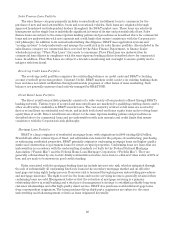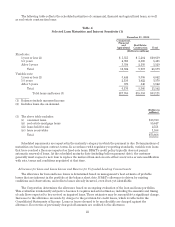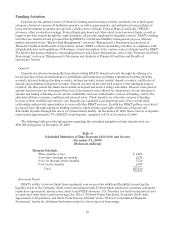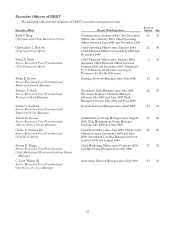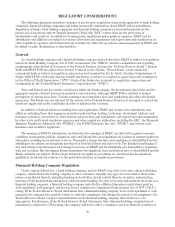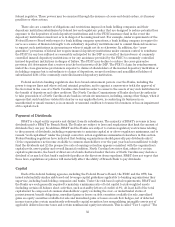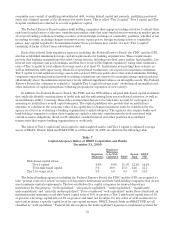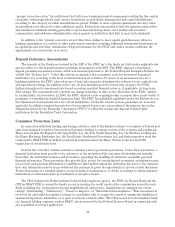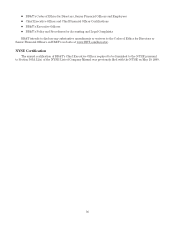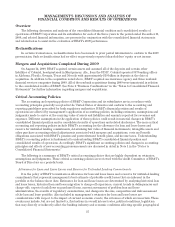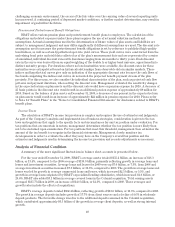BB&T 2009 Annual Report Download - page 30
Download and view the complete annual report
Please find page 30 of the 2009 BB&T annual report below. You can navigate through the pages in the report by either clicking on the pages listed below, or by using the keyword search tool below to find specific information within the annual report.REGULATORY CONSIDERATIONS
The following discussion describes elements of an extensive regulatory framework applicable to bank holding
companies, financial holding companies and banks and specific information about BB&T and its subsidiaries.
Regulation of banks, bank holding companies and financial holding companies is intended primarily for the
protection of depositors and the Deposit Insurance Fund (the “DIF”) rather than for the protection of
shareholders and creditors. In addition to banking laws, regulations and regulatory agencies, BB&T and its
subsidiaries and affiliates are subject to various other laws and regulations and supervision and examination by
other regulatory agencies, all of which directly or indirectly affect the operations and management of BB&T and
its ability to make distributions to shareholders.
General
As a bank holding company and a financial holding company under federal law, BB&T is subject to regulation
under the Bank Holding Company Act of 1956, as amended, (the “BHCA”) and the examination and reporting
requirements of the Board of Governors of the Federal Reserve System (the “Federal Reserve Board”). Branch
Bank and BB&T FSB are collectively referred to herein as the “Banks.” Branch Bank, a state-chartered
commercial bank, is subject to regulation, supervision and examination by the North Carolina Commissioner of
Banks. BB&T FSB, a federally chartered thrift institution, is subject to regulation, supervision and examination
by the Office of Thrift Supervision (“OTS”). Each of the Banks also is subject to regulation, supervision and
examination by the Federal Deposit Insurance Corporation (the “FDIC”).
State and federal law govern the activities in which the Banks engage, the investments they make and the
aggregate amount of loans that may be granted to one borrower, although BB&T FSB is entitled to federal
preemption of various state laws. Various consumer and compliance laws and regulations also affect the Banks’
operations. The Banks also are affected by the actions of the Federal Reserve Board as it attempts to control the
monetary supply and credit availability in order to influence the economy.
In addition to federal and state banking laws and regulations, BB&T and certain of its subsidiaries and
affiliates, including those that engage in securities underwriting, dealing, brokerage, investment advisory and
insurance activities, are subject to other federal and state laws and regulations, and supervision and examination
by other state and federal regulatory agencies and other regulatory authorities, including the SEC, the Financial
Industry Regulatory Authority (the “FINRA”), the NYSE Euronext, Inc. (the “NYSE”), and various state
insurance and securities regulators.
The earnings of BB&T’s subsidiaries, and therefore the earnings of BB&T, are affected by general economic
conditions, management policies, changes in state and federal laws and regulations and actions of various regulatory
authorities, including those referred to above. Proposals to change the laws and regulations to which BB&T and its
subsidiaries are subject are frequently introduced at both the federal and state levels. The likelihood and timing of
any such changes and the impact such changes may have on BB&T and its subsidiaries are impossible to determine
with any certainty. The description herein summarizes the significant state and federal laws to which BB&T and the
Banks currently are subject. To the extent statutory or regulatory provisions are described, the description is
qualified in its entirety by reference to the particular statutory or regulatory provisions.
Financial Holding Company Regulation
Under current federal law, a bank holding company, such as BB&T, may elect to become a financial holding
company, which allows the holding company to offer customers virtually any type of service that is financial in
nature or incidental thereto, including banking and activities closely related thereto, securities underwriting,
insurance (both underwriting and agency) and merchant banking. In order to become and maintain its status as a
financial holding company, a financial holding company and all of its affiliated depository institutions must be
well-capitalized, well-managed, and have at least a satisfactory Community Reinvestment Act of 1977 (“CRA”)
rating. If the Federal Reserve Board determines that a financial holding company is not well-capitalized or well-
managed, the company has a period of time to come into compliance, but during the period of noncompliance, the
Federal Reserve Board can place any limitations on the financial holding company that it believes to be
appropriate. Furthermore, if the Federal Reserve Board determines that a financial holding company has not
maintained a satisfactory CRA rating, the company will not be able to commence any new financial activities or
30


